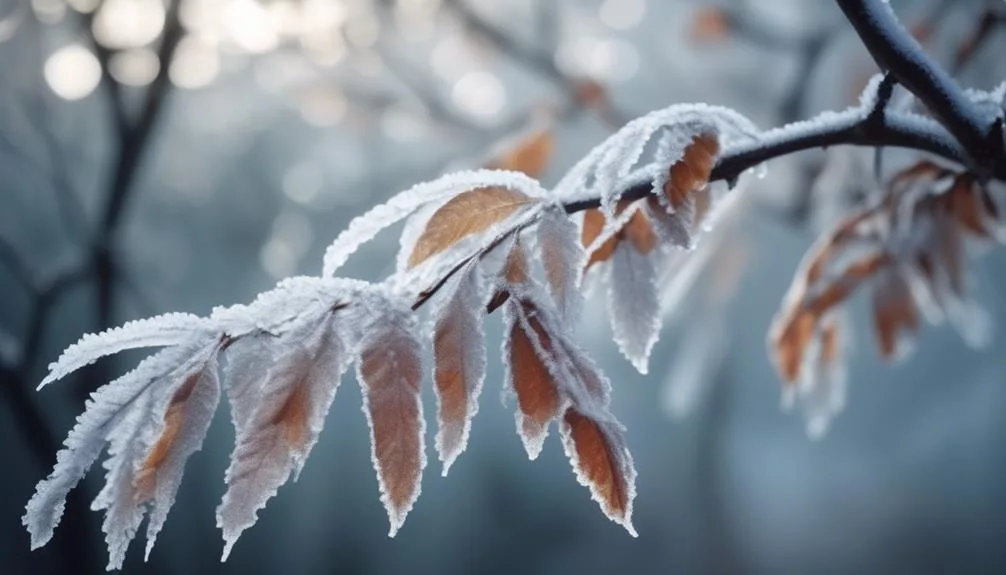Hickory trees, like resilient guardians, endure the changing seasons with strength.
Yet, when frost arrives, can they withstand winter's icy grip? Observing the hickory's sturdy figure may leave you pondering its ability to endure the cold.
The answer lies in nature's delicate balance, and understanding how hickory trees interact with frost is crucial to unlocking their resilience.
Ideal Temperature Range for Hickory Trees
To thrive, hickory trees require a consistent temperature range between 60 and 70 degrees Fahrenheit, providing the optimal conditions for their growth and development. Different hickory tree varieties have varying temperature requirements, with some being more tolerant of cold weather than others.
When temperatures drop below their ideal range, hickory trees employ cold weather strategies to survive. These strategies may include shedding leaves to reduce water loss and insulating their cells to prevent damage from freezing temperatures. However, prolonged exposure to temperatures outside their preferred range can limit the growth of hickory trees, impacting their overall health and productivity.
Understanding the temperature needs of specific hickory tree varieties is essential for ensuring their successful cultivation and longevity in various climates.
Frost Tolerance of Hickory Trees
How do hickory trees withstand frosty conditions and what mechanisms do they employ to survive?
Hickory tree species have developed impressive frost tolerance mechanisms, allowing them to thrive even in colder climates. When faced with frost, hickory trees undergo physiological changes to protect themselves from damage. Here's a closer look at how they achieve this:
- Adaptation of Cell Structure
- Cells within the hickory tree undergo changes in their structure to prevent damage from frost, ensuring the tree's survival.
- Antifreeze Proteins
- Hickory trees produce specialized proteins that act as antifreeze, lowering the freezing point of their tissues and safeguarding them from frost damage.
These remarkable adaptations highlight the resilience of hickory trees and make them well-suited for cultivation in areas prone to frost. Understanding their frost tolerance is crucial for effective hickory tree care and cultivation.
Impact of Frost on Hickory Trees
Frost poses a significant challenge to hickory trees, impacting their growth and overall health during colder periods. Frost damage can cause dehydration in hickory trees, leading to the formation of ice crystals within their cells and tissues, which can ultimately result in cell damage. This damage can weaken the tree's overall structure and make it more susceptible to diseases and pests.
Additionally, severe frost can lead to winter survival issues for hickory trees, as it may hinder their ability to absorb water and essential nutrients from the soil. This can significantly affect their overall health and vigor, making them more vulnerable to environmental stressors.
Therefore, it's crucial to take preventive measures to protect hickory trees from frost damage, especially during colder periods, to ensure their long-term health and survival.
Protecting Hickory Trees From Frost
Protecting hickory trees from the detrimental effects of frost is essential for ensuring their long-term health and survival. Severe frost can lead to dehydration and cell damage, weakening the tree's structure and making it more susceptible to diseases and pests.
Here are two effective ways to protect hickory trees from frost:
- Winter Mulching: Apply a layer of organic mulch around the base of the tree to insulate the soil and regulate its temperature. This helps to prevent rapid freezing and thawing of the soil, reducing the risk of root damage.
- Tree Wrapping: Wrap the trunk of young hickory trees with burlap or tree wrap to shield them from extreme temperature fluctuations. This method protects the bark from cracking and minimizes the risk of frost damage.
These practices provide vital protection, ensuring the resilience of hickory trees during frosty conditions.
Tips for Frost-Resistant Hickory Trees
Wondering what characteristics make hickory trees frost-resistant? Hickory trees are naturally hardy, but providing them with proper winter care can help them withstand frost even better. Here are some tips for maintaining frost-resistant hickory trees:
| Tip for Frost-Resistant Hickory Trees | Description | Importance |
|---|---|---|
| Proper Pruning | Prune your hickory trees in late winter to remove any dead or damaged branches, promoting healthy growth. | Enhances tree structure and resilience. |
| Mulching | Apply a layer of mulch around the base of the tree to insulate the roots and retain moisture, protecting against frost. | Maintains soil temperature and moisture. |
| Tree Protection | Use tree wraps or burlap to shield young hickory trees from harsh winter conditions, preventing frost damage. | Guards against extreme temperatures and winds. |
Conclusion
In considering hickory trees and frost, it's clear that while they can tolerate it to a certain extent, understanding their ideal temperature range and taking precautions is crucial for their well-being.
By being mindful of their frost tolerance and protecting them appropriately, we can help hickory trees thrive even in colder conditions.
This highlights the importance of considering the specific needs of trees in varying climates and the impact it has on their growth.

My interest in trees started when I first saw the giant sequoias in Yosemite.
I was a teenager then, and I remember thinking, “I need to learn more about this.”
That moment stuck with me.
A few years later, I went on to study forestry at Michigan Tech.
Since graduating, I’ve worked in a mix of hands-on tree care and community education.
I’ve spent over ten years helping people understand how to plant, maintain, and protect the trees in their neighborhoods.
I don’t see trees as just part of the landscape.
They are living things that make a real difference in our daily lives.
